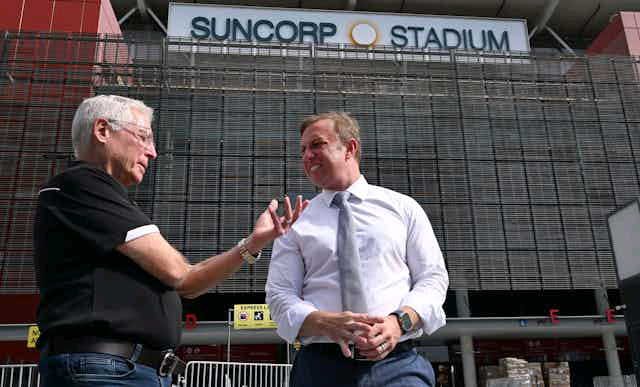Coming back from a false start? How far along is the preparation for the 2032 Olympics and Paralympics in Brisbane?.
Premier of Queensland Steven Miles undoubtedly hoped that by announcing Brisbane’s Lang Park (sponsored name Suncorp Stadium) as the site of the 2032 Olympic and Paralympic Games’ opening and closing ceremonies, rumors regarding all the proposed Olympic venues, particularly the rebuild of Brisbane Cricket Ground (Gabba), would finally be put to rest.
However, what does this signify in a broader sense for the budget of the Games and the lasting impact they will have on Brisbane and south-east Queensland?
The “new norm” of the Olympics
Cost overruns are a well-known feature of the Olympic Games; since 1960, every host nation has incurred expenses that were substantially higher than projected, with an average expenditure of almost 2.5 times the original budget.
The massive event has drawn a lot of criticism as a result of these budget overruns and the high expense of vying just to host the Games.
Under pressure to become more environmentally friendly, the International Olympic Committee (IOC) implemented a set of changes known as the “new norm.” By lowering the amount of new infrastructure needed and promoting the use of temporary and reusable venues, the IOC’s new standard was created to lower the expenses associated with organizing the Games.
The Brisbane bid was more reasonable and practical because of these “new norm” concepts.
The question of whether the state government is adhering to these ideals and is able to provide a sustainable, legacy-driven event within budget has been the subject of growing public discussion since obtaining the Games in July 2021.
The stadium sagas in Queensland
In essence, the bid document, Brisbane’s IOC Future Host Commission Questionnaire Response, estimated expenses of A$4-5 billion, with an additional $7.1 billion for infrastructure. This includes the primary Olympic venue, the Gabba, being used after renovation.
But Annastacia Palaszczuk, the former premier of Queensland, swiftly unveiled a contentious proposal to demolish and reconstruct the Gabba from the ground up.
After facing harsh criticism, Miles decided to appoint former Brisbane Lord Mayor Graham Quirk to head an impartial Sport Venue Review in December 2023.
One of the report’s most important recommendations was denied, despite the Queensland government having approved 27 of the report’s 30 recommendations when it was released on March 18. The report suggested controversially—and seemingly against the ideas of the “new norm”—constructing a brand-new stadium on a greenfield location in Victoria Park.
It also suggested that the Gabba be demolished after the new stadium was finished.
Miles quickly disregarded the suggestion, stating he had been working on a different plan for a few weeks, and declared Suncorp Stadium will be the primary venue for the opening and closing ceremonies of the Games.
The announcement that the Queensland Sport and Athletics Centre (QSAC) would be upgraded and used as the athletics venue was another jab at the Quirk Review, given the review concluded that such an improvement would not provide legacy advantages.
Suncorp Stadium’s selection seems to be a victory for the “new norm,” since it uses an existing facility that will be preserved as a legacy asset while saving about $3.4 billion that was intended for the renovation of the Gabba.
If updating QSAC results in a significantly improved asset for the community after the Games, then it is also generally consistent with the new norm principles.
Utilizing Suncorp is not cost-neutral, either, as Miles suggests that Suncorp and the Gabba would split the cost “roughly half-half” if upgrades exceeded $1 billion.
In addition, QSAC will need a major renovation to bring it up to code. The venue is currently underserved by public transportation, and improving the accessibility issues that have been raised will probably require additional funding.
Furthermore, expenses will continue to be incurred for maintaining the Gabba, which the Quirk evaluation refers to as a “end-of-life” facility.
The Gabba is currently in dire need of renovations because it does not adhere to contemporary building requirements, especially when it comes to accessibility for those with disabilities. The Queensland government has committed to a $500 million “modest” renovation after consulting with stakeholders, including Cricket Australia and the AFL.
Whether the redevelopment of these venues will give Queensland top-notch facilities that maximize long-term benefits for the community is the longer-term question that still has to be answered.
Lessons learned and future actions
What can we learn from this most recent incident?
Major sporting events are always highly political to plan and grow.
Although it’s important to steer clear of extremely costly venues that won’t be used much after the Games, host cities shouldn’t be prevented from proposing completely new venues just because of the IOC’s new standard.
If new venues enable long-term community use after the Games conclude and firmly assist the long-term development plans of the host city, they may very well be in line with the new norm principles.
Establishing the independent coordination body is crucial for Brisbane 2032 in order to offer a strong governance framework for the planning, designing, and building of the proposed venues.
Following a somewhat misguided beginning, we cannot afford any further postponements.
GET RELATED CONTENTS ON: BLACKSPORTNEWS.CO.UK
